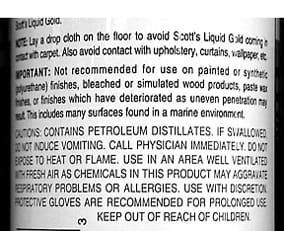Many of us breathe a deep sigh of relief when we leave the high-stress work, school, or social world behind and walk into our familiar, comfortable homes to be happily greeted by our canine companions. But few people realize how potentially dangerous those breaths can be – those and every other breath you and your companion animals take in your home.
While we often consider our homes as sanctuaries – places of peace and safety – we may actually be living in danger zones filled with toxic airborne chemicals. Many of the building materials and housekeeping substances we use in our homes are air pollutants, capable of causing acute and long-term damage to our health, as well as the health of our dogs. We are only rarely aware of indoor air pollutants in the air we breathe – and many people are completely unaware of the potential damage that diminished air quality has on the health of every animal (including us) breathing that air. In fact, our companion animals are even more vulnerable than we are to the damaging effects of indoor air pollution.
It’s in the air

When chemicals evaporate into the air (the scientific term for this is “volatilize”) at room temperature, they become part of the air we breathe. When volatile organic compounds (VOCs) become airborne, they can influence the health of any animals (including humans) in the home. Elevated temperatures (during warm seasonal periods, or when indoor heating units are engaged) and humidity can release even greater quantities and numbers of the chemicals into the air, thereby increasing the number of total volatile organic compounds (TVOCs) in our “breathing space.”
According to the Environmental Protection Agency (EPA), “indoor air pollution poses high risks to human health, especially sensitive populations, and has ranked among the top four environmental risks in relative risk reports.” Studies show that indoor air in homes is, on average, two to 20 times more polluted than the outdoor environment. Most people are shocked to learn that it’s not unheard-of for indoor chemical concentrations to rise to as much as 100 times the outdoor air concentration! But even at much lower levels we find TVOCs to cause the onset of chronic disease in both humans and animals.
Today, we are seeing new causes and mutations of disease as a result of the rapidly expanding development of the synthetic chemical industry. A study by the EPA found a staggering 900 chemicals commonly present in the home environment – from dry-cleaned fabrics, shampooed carpets, household cleaning products, foam in upholstery, carpet glues and pads, to perfumes and colognes. Between 150-200 chemicals are considered to have the potential to cause cancer and genetic mutations.
Effects of exposure
This “soup” of synthetic chemicals can affect multiple body systems and is cited as causing health-damaging effects to the musculoskeletal system, upper respiratory tract, nose and sinuses, immune system, digestive system, heart and blood vessels, endocrine system, reproductive system, central nervous system, internal organs, and skin. These diseases are directly linked to the presence of these chemicals in the indoor air environment.
Our reference data comes from animal laboratory studies and human exposure incidences in homes, office environments, and industrial settings. Some of the exposures are from acute, high level exposures of toxic substances (particularly in industrial settings and animal laboratories), while others are from chronic, low levels. Exposure to low levels of chemicals can cause allergic sensitization of the airways in animals, indicating the weakening of systems, and further reducing the animal’s ability to cope with the increasingly polluted indoor environment. It is these chronic, low levels of chemicals that we are addressing in the indoor home environment.
The common organic compounds found in our homes have many known health-damaging effects, even in low levels. While many have the potential to cause emotional disturbances (a depressed central nervous system resulting in low energy, depression, and decreased appetite) in our animals, it is the mutagenic (mutation-causing), teratogenic (fetal damage-causing), and carcinogenic (cancer-causing) properties that are the most impairing and life-threatening.
The most prevalent health effects from exposure to chemicals are skin diseases (dermatitis), respiratory impairment (irritation, sensitization), neurotoxic effects (adverse effects on the central nervous system), and cancers from long-term exposure, along with a number of diseases affecting specific organs such as the liver and kidney. The degree of health impairment is very much dependent on the level of exposure, its duration, and the individual exposed.
Of course, all individuals – human or animal – display varying levels of sensitivity to airborne pollutants. By the early 1990s, 15 percent of the human population had already developed heightened sensitivities to chemicals, according to the National Academy of Sciences (NAS). It is unknown what percentage of our canines experience chemical sensitivities, but we do know, that like humans, dogs with strong, healthy, immune systems will be less susceptible to the toxic overload than dogs with chronic disease (such as hot spots, ear infections, allergies, asthma, diabetes, thyroid, intestinal, urinary problems).
Some dogs (with strong immune systems) may live in homes with chart-topping levels of air pollutants, and not visibly display signs of poor health. On the other end of the scale, other dogs may immediately suffer acute distress – such as asthma, anxiety, depression, itchy, runny eyes, or severe skin irritation – from the introduction of any new or existing toxic chemicals in the home. But because most people have a generally low level of awareness of indoor air quality and its potential affect on their dogs, even if a dog does show signs of sensitivity, few people can make the connection between the signs and their true causes. And long-term exposure to even very low levels of toxins can cause insidious and deadly effects.
Pesticides pose special risks
Of the approximate 200 such chemicals currently known to cause cancer in humans (with many more known to cause these disease states in animals), pesticides are among the most serious. Pesticides are designed to kill, and do not discriminate. Pesticides are commonly found in pet products for dogs such as flea collars, flea powders, shampoos and dips, carpet treatments, house foggers, and even some pet foods. Chemicals found in these products include organophosphates, chlorinated hydrocarbons, synthetic pyrethroids, petroleum distillates, synergists, petroleum hydrocarbons and aromatics, including xylene and xylene range aromatic compounds.
Chlopyrifos (Dursban), an organophosphate insecticide, is one of the most prevalent compounds in pet products. Due to the health-damaging effects of Dursban, the Environmental Protection Agency (EPA) implemented a phase-out in pet products for 2001, and has added Diazinon to follow suit. Chlopyrifos causes peripheral neuropathy (nervous system disorders), involving the nerves of the limbs. The symptoms are unusual sensations (numbness, burning, tingling ) muscle weakness, or difficulty with coordinated movement. Chlopyrifos also causes genetic damage. In a study of over-the-counter pet pesticide products, nearly 50 percent are known or suspected to cause tumors or cancer, upward of 40 percent are known or suspected to cause reproductive damage, and more than 25 percent are known or suspected to cause genetic damage.
Samples of indoor dust have indicated pesticides in significant amounts in household dust tracked into the house and present in carpeted floors. Dr. Marion Moses cites a recent study showing that “dogs were more likely to have lymphoma if their guardians used chemical lawn treatments.”
Dogs more vulnerable
As we mentioned earlier, our companion animals are even more vulnerable than we are to the damaging effects of indoor air pollution. There are several reasons for this.
First, it is not unusual for dogs who live inside to spend almost 100 percent of their lives indoors. Even dogs who are walked for, say, a total of an hour every day, are still indoors for 23 hours a day!
Second, many common solvents have a higher molecular weight than air; thus they settle toward the floor. Any animal that spends most of its time near or on the floor is more susceptible to these chemical exposures.
Due to their body mass and their rate of respiration, dogs, like infants, are also more susceptible than we are to toxic chemicals in the air. For their body size, the amount of air they breathe is substantially more than a child or an adult, thereby exposing them to greater quantities of toxicants than we might breathe in the same air space. Also, the short life span of dogs leads to shorter latent periods during which biological effects from pollution can be detected.
If they are paying attention, humans are able to recognize and investigate the early symptoms of ill health when they themselves experience them – things like headaches, feelings of depression or anxiety, and nausea. Obviously, our dogs are not able to let us know they are experiencing such subtle, early signs of declining health. Not recognizing the disease-causing potential of pollutants in the indoor air can result in our animals’ symptoms, over time, developing into worsening disease states such as reproductive abnormalities, genetic mutations, cancer, and other chronic disease. While the onset of acute disease among animals has fallen over the past 40 to 50 years, Don Hamilton, DVM, says the rise in chronic disease is increasing annually.
Learn about chemicals
With few exceptions, nearly every commercial and consumer product we use in our homes and yards today has a health-damaging component to it. However, with an increased awareness of these risks, you can work toward effectively lessening the toxic burden in our indoor and outdoor environment for your family, human and canine. There are some basic methods that anyone can use to help identify how, why, and when to avoid the use of products that have the ability to contaminate their indoor air. The best method is education – educating yourself about the products you use by researching each of the listed ingredients on the packaging.
The product label is the place to begin your investigation; most products give a list of active ingredients. Unfortunately for the consumer, it is often the “inert” ingredients that are most health-damaging, and these are not disclosed to the consumer and are considered proprietary information by the manufacturer. This is especially troubling when you consider that some products contain upward of 99 percent inert ingredients! Of course, few of us are familiar with the health effects of the chemicals that are listed on the label. However, concerned consumers can gain access to this information.
Product manufacturers are required by law to complete a “Material Safety Data Sheet” (MSDS) on every chemical product they produce and make it available to consumers upon request. The MSDS includes a list of the active ingredients: the hazardous chemicals in the formulation, the degree of health effects, safety procedures when handling the product, and even cleanup instructions in case of a spill. (Again, unfortunately, even the MSDS does not contain information about the product’s inert ingredients; the only way to get this information is through your doctor or veterinarian.)
Do make it a point to look up every chemical listed on the label of products you consider using; chemical reference books such as the Merck Index list the health-damaging properties of every compound. This research will help you determine the safety of the product before using it in your home.
Don’t judge a product on the basis of the warnings on the label or even the MSDS alone. While these serious and valid warnings are based on toxicology tests, currently only two to three percent of the 100,000 chemicals in production today have been tested for toxicity. Chemicals not tested and classified as hazardous by the Occupational Safety and Health Administration (OSHA) can be used in products and not required by law to be listed on the manufacturers’ MSDSs.
Trust your nose
You can also learn to identify many potentially dangerous aromatic air pollutants by their odor and by your (or your animals’) physical health response to them. Our sense of smell is reptilian – hardwired to our brain This is our most primitive sense, upon which we can instinctively rely when we are exposed to a toxic chemical. It is important to register the odor upon initially entering your home. Within 20 seconds, our olfactory senses desensitize to any odors present. Remember how wonderful the aroma of sautéed garlic and onions smells upon coming into the kitchen from outdoors, and how quickly we become accustomed to the initial pleasure.
Unfortunately, a toxic chemical will register an entirely different physical response. The onset of a dull headache, rapid heart beat, difficulty breathing, tearing eyes, and/or sharp pain in the skull are possible responses to a chemical exposure. If you pay attention initially, you will be closer to identifying the source and removing your dog and yourself from the potential harm. While identification of the air pollutants is important, understanding what to avoid in the first place is even more important.
Change purchasing patterns
Prevention – that is, simply not bringing potentially dangerous products into your home – is the most effective strategy for preserving the safety of the air you and your dogs breathe. If building or remodeling your home, avoid using products that are known to be harmful. Sheet vinyl flooring, for example, contains polyvinyl chloride (PVC) and plasticizers, which are linked to cancer. Choose ceramic tiles instead.
When maintaining an existing home, try to use natural products. Consider how this simple act can prevent unneeded chemical exposures. Using a vinegar and water solution, for example, can prevent exposures to the ammonia, naphthalene, chlorine, and ethylene glycol commonly found in most brand-name glass or floor cleaners. A naturally maintained lawn sporting bio-diversity (read, containing a few weeds) keeps our dogs safe from health-damaging herbicides (for example, 2,4-D, atrazine, glyphosate, trichlopyr – weed killers that can damage kidneys and other organs). Hand washing delicate clothing versus using a dry cleaning service keeps perchloroethylene (Perc) from entering our homes (Perc has been linked to cancer in humans). Many air fresheners contain paradichlorobenzene, a carcinogen; a simple lemon or vinegar solution for cleaning will lend our homes a pleasing aroma that is far healthier.
Thinking “old-world” rather than “modern-technology” when selecting products will keep you attuned to the plethora of chemicals that infiltrate and cause health-damaging effects.
In general, look for alternatives to any petroleum-based products you want to buy. All petroleum-based products “off-gas,” that is, release health-damaging chemicals into the air. Instead of petroleum-based products, choose inert, self-maintaining, natural materials. There are low- and non-toxic alternative materials for every home and yard activity. When painting, look for a water-based paint with fewer than 50 VOCs (check out the manufacturer’s specification sheet for this information). Use wool area rugs over a hard flooring surface instead of a tufted carpet (backing adhesive has styrene butadiene which is linked to sick building syndrome). And in your yard, remove rotting timbers from the foundation of the house to avoid the introduction of termites and the use of toxic chemical spraying.
Unbeknown to us, our own personal hygiene can introduce harmful chemicals into our homes. Synthesized perfumes contain neurotoxic chemicals. The National Institute of Occupational Safety and Health (NIOSH) found 884 neurotoxic chemical compounds used in the cosmetic and perfume industries. When the EPA tested random samples of perfumes and automobile products off the shelves, without exception, each one contained a common solvent: toluene. Along with formaldehyde, this chemical is one of the most prevalent health-damaging solvents to which our animals and we are exposed. It is classified as a carcinogen and neurotoxic chemical. Our use of incense, wood-burning stoves, and cigarette smoking can exacerbate upper respiratory problems in our dogs. Many dishwashing and laundry detergents as well as fabric softeners release scents that contain harmful chemicals. Shop carefully and wisely and avoid these exposures. There are many alternatives available today that can give us some relief from the harmful effects.
Finally, consider the impact of everything you use and do in your indoor and outdoor environment – it all adds up!
For example, the use of formaldehyde is ubiquitous in today’s homes; it is used to preserve paints and stains, is a carrier in fabric dyes, a component in composite woods such as plywood and particle board – and is a known human carcinogen. The prevalence of its use in common household products is reason alone to discontinue buying products that contain it.
As you can see, awareness and conscious action are major keys to preserving our health, as well as the health of our beloved canine companions.
Also With This Article
Click here to view “How to Detoxify Your Canine Naturally”
Click here to view “If Your Dog is Ever Exposed to Chemicals – React Quickly”
Click here to view “Toxins That Can Arise in Dog Food”
-By Kathleen Dudley
Kathleen Dudley lives in New Mexico, where she is a professional indoor air quality consultant, writer, and photographer. She teaches and lectures in college and conference circles on material toxicity and indoor air quality, and has had an interior design practice for 22 years. Ms. Dudley’s photography appears in Homeopathic Care for Cats and Dogs by Don Hamilton, DVM.






